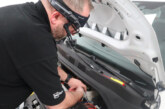
CTEK outlines exactly why batteries should not be ignored when undertaking vehicle diagnostic and repair.
Modern commercial vehicles are packed with on-board technology that not only improves and enhances vehicle performance, but also ensure protection, safety and comfort for the driver.
Whether the vehicle is in use or in the diagnostic workshop, the battery is being placed under great strain – we, therefore, cannot ignore the demands that complex vehicle technologies are placing on commercial workshops.
CTEK’s research has identified that as many as one in four commercial vehicles arriving in the workshop have a battery problem, a threat that could cause you problems when carrying out diagnostic work on the vehicle.
This is pointing out the obvious, but for the avoidance of doubt, fault code diagnostics requires the ignition switched on without the engine running. This means that during the diagnostic process, the vehicle’s systems are operated solely from the power of the battery.
CTEK encourages proactive battery charging and support, and it recommends that, whatever work is being undertaken on the vehicle, you should always hook it up to some form of battery support – even leaving the vehicle door open will drain the battery.
Battery support is a vital activity – often not fully appreciated for its importance in saving technicians time, insuring against battery failure during the diagnostic process, and, in turn, preventing unnecessary down time, lost vehicle data, and, worst still, damage to the ECU.
When undertaking diagnostic procedures, you should always use dedicated battery support, as opposed to battery charging. That’s because the vehicle needs a supply of clean, constant voltage that can quickly react to any peaks in demand on the battery.
What to look out for
A standard battery charger will struggle to cope with these sudden increases in current demand, which is when the battery, and possibly the diagnostic process will fail. On the other hand, a battery charger may actually increase battery voltage beyond operating levels, that can again cause the diagnostic process to fail.
Battery support will also guard against loss of battery charge, protecting the battery from discharge when the work is complete and the vehicle is back out on the road.
The MXTS 40 from CTEK provides a stable voltage and up to 40amps (12V mode) and 20Amps (24V mode) of fully regulated power to prevent loss of charge and damage to the battery, so it’s ideal for a wide range of commercial vehicles with average power consumption.
If even more power is required, the MXTS 70 provides up to a 70amps of battery support (35Amps) in 24V. This unit gives the flexibility to cover all vehicles, including high specification vehicles with large flash programming demands.
Using a CTEK battery charger in ‘supply’ mode maintains an ideal battery voltage throughout the period of repair or reprogramming, at the ideal voltage.
Protect against de-rating
Battery support units deliver high levels of power over a relatively long period of time, and as a consequence they can generate a lot of heat. As a safety precaution, many units are set to derate. This is a process whereby the unit will reduce charge levels, and at really high temperatures reduce current output. De-rating is becoming a huge challenge to many workshops, risking disruption to the diagnostic or reprogramming procedure.








